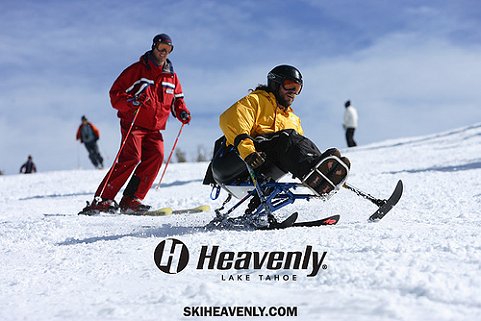
Paralympics Cross-country Skiing. Amazing Athletes do it all.
“Many of life's failures are men who did not realize how close they were to success when they gave up.”
Thomas Edison Paralympics Cross-country Skiing will be taking place at the Whistler Olympic Park located just south of Whistler in the spectacular Callaghan Valley. Individuals and teams are beginning to visit the park to become familiar with the facilities and get the layout of the land.For instance, the 2007 Paralympics cross-country skiers USA long distance champion Monica Bascio and silver medalist Bob Balk and Greg Mallory, all sit-ski athletes recently (Aug. 2008) paid a visit.
The skiers stated the course offers excellent terrain for sit-ski competition. It will be very fast.
Kreamelmeyer said after checking the course that the terrain was very good and deceivingly difficult.
As with all of the paralympic winter sports, athletes compete against athletes with similar disabilities and are placed in different categories.
Those with visual impairment ski with a guide who will direct with the voice. Standing skiers will use the same type of ski equipment as skiers without disabilities. Those who have no use of their legs will compete using the sit-ski sledge. These sledges have skis attached to the bottom as runners.
Two techniques.
There are two techniques used in Paraltmpics cross-country skiing. Free style and Classic.
Free style skiing is done on the section of track without groomed tracks in the snow. The skier uses a skating motion, pushing off with the edge of the skis. This method allows the skier to make good time on the course and is generally about 8% faster over a distance than the classic method. The skis used are shorter than classical.
Classical technique skiing is done from the sitting position on the sit-ski. These skiers are unable to move out of the parallel tracks and the skier propels the sit-ski along with the specially adapted poles.
In Sun Valley Idaho the Sun Valley Adaptive Sports hold a recruitment camp each year for athletes who excel in other sports. Here they are taught how to cross country ski on a sit ski sledge. One of the coaches is Paralympic Silver Medalist Bob Balk who also claims the title to the National Champion Nordic Sit-skier.
Staff Sgt. Erik Avla was the first serviceman to be wounded in the Iraq invasion and he has found new hope at the Sun Valley facility. The director of Sun Valley Adaptive Sports , Marc Mast met Erik and he soon had Erik up on the slopes with outrigger skis and gave him a few days of instruction.
Erik stated “You balance soon begins to come back to you, the more you ski, the quicker it comes back. I couldn’t believe that only nine months after my injury I was skiing again.”
Wheels can be attached to the sit-ski so that dry land and gymnasium training can be carried out. Paralympics cross-country skiing is a sport where upper body training is a must. A rigorous training program is required because all of the propulsion is done only with the shoulder and arm muscles.
The competitions are held over short, middle and long distances. From 2.5 to 20 kilometers. The racers start 30 seconds apart. The International Paralympic Committee makes use of the Nordic Percentage System which is a handicapping system for each category. That handicap time is added to the skiers time. The winner is the one with the lowest calculated time.
In the relay races, each team skier skies one leg of the circuit. The teams are made up from different categories that are balanced out so that each team is even starting out. This eliminates time calculations. The first team across the finish line is the winner.
Wheelchair Curling is a sport where strategy takes over.
Return from Paralympics Cross-country Skiing to Whistler Outdoors



